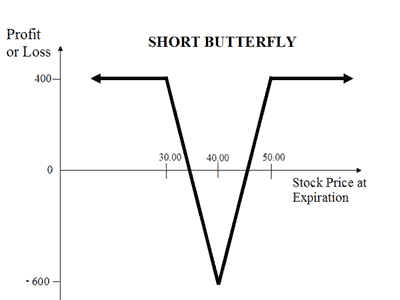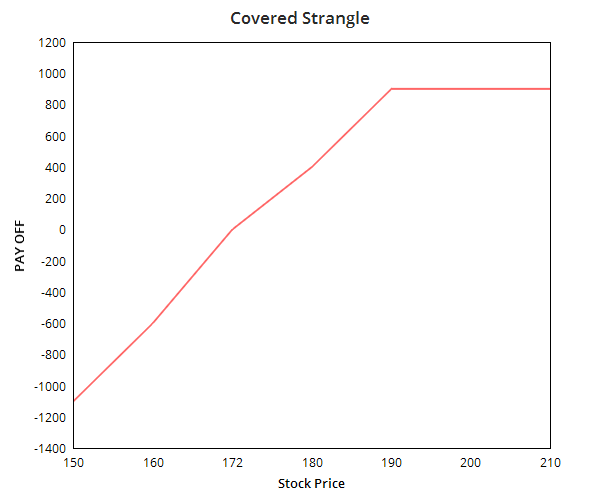 Zerodha (Trading Account)
Zerodha (Trading Account)
FREE Equity Delivery and MF
Flat ₹20/trade Intra-day/F&O
 Zerodha (Trading Account)
Zerodha (Trading Account)
FREE Equity Delivery and MF
Flat ₹20/trade Intra-day/F&O

|
|
Compare Short Call Butterfly and Covered Strangle options trading strategies. Find similarities and differences between Short Call Butterfly and Covered Strangle strategies. Find the best options trading strategy for your trading needs.
| Short Call Butterfly | Covered Strangle | |
|---|---|---|
 |
 |
|
| About Strategy | Short Call Butterfly (or Short Butterfly) is a neutral strategy similar to Long Butterfly but bullish on the volatility. This strategy is a limited risk and limited profit strategy. This strategy consists of two long calls at a middle strike (or ATM) and one short call each at a lower and upper strike. All the options must have the same expiration date. Also, the upper and lower strikes (or wings) must both be equidistant from the middle strike (or body). In simple terms, it involves Sell 1 ITM Call, Buy 2 ATM Calls and Sell 1 OTM Call. The strike prices of all Options should be at equal distance from the current price as shown in the example below. The usual Short Butterfly strategy looks like as below for NIFTY current index value as 1... Read More | The covered strangle option strategy is a bullish strategy. The strategy is created by owning or buying a stock and selling an OTM Call and OTM Put. It is called covered strangle because the upside risk of the strangle is covered or minimized. The strategy is perfect to use when you are prepared to sell the holding or bought shares at a higher price if the market moves up but would also is ready to buy more shares if the market moves downwards. The profit and in this strategy is unlimited while the risk is only on the downside. |
| Market View | Neutral | Bullish |
| Strategy Level | Advance | Advance |
| Options Type | Call | Call + Put + Underlying |
| Number of Positions | 4 | 3 |
| Risk Profile | Limited | Limited |
| Reward Profile | Limited | Limited |
| Breakeven Point | 2 Break-even Points | two break-even points |
| Short Call Butterfly | Covered Strangle | |
|---|---|---|
| When to use? | This strategy is meant for special scenarios where you foresee a lot of volatility in the market due to election results, budget, policy change, annual result announcements etc. |
A covered strangle strategy can be used when you are bullish on the market but also want to cover any downside risk. You are prepared to sell the shares on profit but are also willing to buy more shares in case the prices fall. |
| Market View | Neutral When you are unsure about the direction in the movement in the price of the underlying but are expecting high volatility in it in the near future. |
Bullish The Strategy is perfect to apply when you're bullish on the market and expecting less volatility in the market. |
| Action |
|
Buy 100 shares + Sell OTM Call +Sell OTM Put The covered strangle options strategy can be executed by buying 100 shares of a stock while simultaneously selling an OTM Put and Call of the same the stock and similar expiration date. |
| Breakeven Point | 2 Break-even Points There are 2 break even points in this strategy.
|
two break-even points There are 2 break-even points in the covered strangle strategy. One is the Upper break even point which is the sum of strike price of the Call option and premium received while the other is the lower break-even point which is the difference strike price of short Put and premium received. |
| Short Call Butterfly | Covered Strangle | |
|---|---|---|
| Risks | Limited The maximum risk is limited. Maximum Risk = Higher strike price- Lower Strike Price - Net Premium |
Limited The risk on this strategy is only on the downside when the price moves below the strike price of the Put option. |
| Rewards | Limited The profit is limited to the net premium received. This happens when the price of the underlying is trading beyond the range of strike prices at expiration date. |
Limited The maximum profit on this strategy happens when the stock price is above the call price on expiry. The profit is the total of the gain from buying/selling stocks and net premium received on selling options. |
| Maximum Profit Scenario | All Options exercised or not exercised |
You will earn the maximum profit when the price of the stock is above the Call option strike price on expiry. You will be assigned on the Call option, would be able to sell holding shares on profit while retaining the premiums received while selling the options. |
| Maximum Loss Scenario | Only ITM Call exercised |
The maximum loss would be when the stock price falls drastically and turns worthless. The premiums received while selling the options will compensate for some of the loss. |
| Short Call Butterfly | Covered Strangle | |
|---|---|---|
| Advantages | This strategy requires no investment as net premium is positive and received. It allows you to benefit from high volatile market scenarios without the need to speculate on the direction of price movement. |
|
| Disadvantage | Profitability depends on significant movement in the price of the underlying. |
|
| Simillar Strategies | Long Straddle, Long Call Butterfly | Long Strangle, Short Strangle |

Add a public comment...

FREE Intraday Trading (Eq, F&O)
Flat ₹20 Per Trade in F&O
|
|